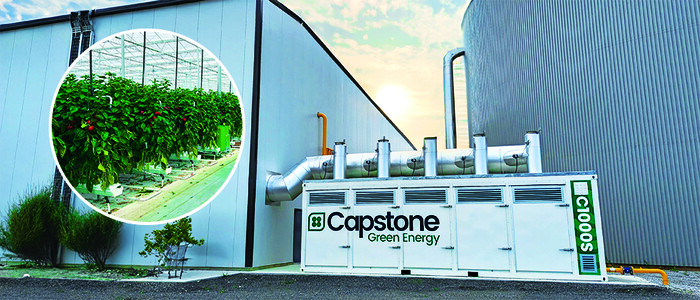CHP Helps Greenhouses Grow Better, Save Money, and Reduce Emissions

Today’s commercial greenhouse operators are seeking innovative ways to balance crop health and yield with overall operating costs. A Combined Heat and Power (CHP) system might just be the “silver bullet,” not only to address both of these needs, but also to provide power security and reduce carbon emissions at the same time.
CO2 Is Good for Growth
By increasing the concentration of CO2 inside the greenhouse, growers create an environment that is optimally conducive to plant growth. To create these conditions, growers essentially have two options: purchase liquid CO2 or produce CO2 onsite. While CO2 delivery allows for more control and precision, it can be cost-prohibitive. The alternative is to find a cost-effective way to produce CO2 onsite. Enter Capstone microturbine-based CHP.
In a Capstone CHP system, a microturbine (or several microturbines packaged together) is installed at the greenhouse facility to generate electricity, heat and cooling using natural gas or other fuels such as biomass that the agriculture sector produces in high quantities. As the microturbine operates, it produces clean exhaust as a byproduct The clean exhaust from the microturbine delivers an elevated level of CO2 to the plants while maintaining low levels of CO, NOx, and hydrocarbons.
In commercial greenhouses, integrating microturbines supports the CO2 enrichment process, accelerating plant growth. Studies show that providing elevated CO2 levels can increase photosynthesis by up to 50% and reduce water consumption by limiting evaporation losses. Greenhouses using the clean exhaust from CHP fuel combustion can enhance produce yields while reducing their carbon footprint.
A CHP Case in Point
@VergentPower recently installed a Capstone CHP system at @HaciendaNorthFarms. While producing free CO2 onsite was certainly a significant benefit, the company’s primary objective was to augment their energy supply to accommodate an expansion that the local utility would have struggled to supply.
At the heart of Hacienda North’s new system is a Capstone C1000S, a modular unit composed of five 200kw microturbine engines able to operate together or independently. The system, which is also integrated with a 500kW solar PV array, is configured as a heat recovery system to produce hot water and CO2, essentially for free.
With this highly efficient cogeneration system, Hacienda North Farms was able to achieve their primary goal of energy independence. The system delivers 99% uptime and is over 90% efficient, while also being able to power the entire facility even when operating in off-grid mode. That degree of efficiency, in combination with renewable solar power, has allowed the farm to reduce greenhouse gas emissions by 30%.
You can learn more about the Hacienda North power system and its success in this video.
Now Is the Time to Get Energy Smart
As global energy costs continue to rise and reliability becomes an ongoing concern, agriculture businesses that make smart energy choices today can reap many benefits including more successful crops, cost savings, power reliability, and emissions reductions. That’s a smart way to grow!
Interested in seeing if CHP is right for your business? Get in touch.







